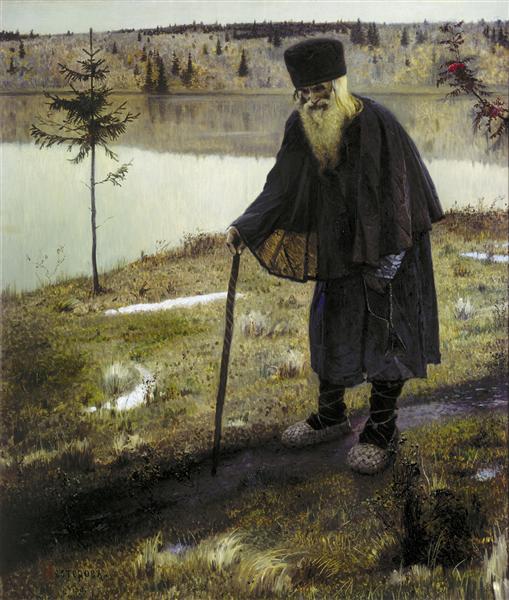
The Hermit is the first significant painting to reveal the originality of Nesterov’s art. Its topic was not so new, many artists of the academic and Wanderers direction turned to it. But among the former, the image of a desert-dweller turned out to be blissfully semi-official, while the latter were inclined to treat him critically and condemn him for leaving the world.
Nesterov was the first, with such sincerity and power, to poeticise a man who had renounced vain worldly passions and found happiness in the solitude and silence of nature. His old monk is a simple man, with a naive faith in God, not experienced in religious and philosophical philosophies, but pure in heart, sinless, close to the earth – this makes him so happy.
The Nesterov hero was inspired by Russian literature – Pimen in Pushkin’s Boris Godunov, Soborians and other heroes, especially Elder Zosima in The Brothers Karamazov by F. Dostoevsky. But Nesterov found this human type in life. He painted his hermitage from Father Gordey, a monk of the Trinity-Sergius Lavra, attracted by his childish smile and eyes shining with infinite kindness.
New for Russian painting was not only the image of the elder, but also the landscape, remarkable for its spirituality. He is devoid of external beauties, gray and meager in his early winter nakedness, but piercingly poetic. A stunted Christmas tree appears in it, bunches of red rowan – Nesterov’s favorite “heroes”. The artist treats them as living beings. A deep inner harmony connects man and nature. In the brownish-gray color of the picture, the influence of the Wanderers painting is still preserved, but this is already the unique Nesterov world of Holy Russia.
Year of painting: 1889.
Painting dimensions: 143 x 125 cm.
Material: canvas.
Writing technique: oil.
Genre: portrait.
Style: symbolism.
Gallery: State Tretyakov Gallery, Moscow, Russia.